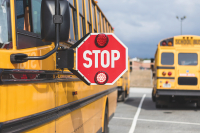Summertime and the reading’s hazy
On the Road by Jack Kerouac. Penguin Classics. 310 pages
Summertime, and the living is easy ...
For most of us Gershwin’s line remains true. The pace of life slows in the summer; the days grow longer; the evening air fills with the scent of cut grass and grilled burgers. July and August offer a welcome hiatus from planned activities for parents and children alike. For teenagers, summer also offers a shift from the worries and cares of the academic year. Many teens work during the summer, putting money aside for a car or college. Others travel, flying off to Romania on a church mission trip or to South America on different American ambassador programs. Others sleep the morning away, hang out, lift weights to play football in the fall, work at various volunteer activities, or engage in a myriad of other diversions.
Despite these dissimilar plans and activities, many teens do share one common experience during their long vacation. This is the notorious summer reading list.
A few unusual young people actually revel in being required to read Hemingway or Homer or Jane Austen over the summer. A much larger percent probably views vacation reading assignments as another malady of adolescence, like pimples, undesired weight, and braces. A third group — I imagine as its representative a male sitting near the rear of a classroom, drawing caricatures or cars while the teacher explains Hamlet’s angst — ignores the literature list altogether. Our young man recollects only the day before classes begin that he was supposed to have read about some girl named Jane Air. (“It’s spelled E-Y-R-E, for heaven’s sakes!” his mother tells him, resisting the urge to whap him on the head with the newly purchased tome as they leave the local bookshop.)
Recently I stood in a local bookstore that features a section called “School Reading Lists.” Here were more than 120 titles, ranging from Pearl Buck’s The Good Earth to Dan Brown’s The DaVinci Code, from Dostoevsky’s The Brothers Karamazov to Betty Smith’s A Tree Grows in Brooklyn. An employee of the store informed me that the section was built from reading lists submitted by teachers and from educated guesses on the part of the bookstore staff.
Related Items
As a bibliophile, I had read most of the books in this section; I stood before them as a friend. As a teacher, I approved of most of the titles I saw here, though I did pause to ask what sort of monster would assign high-school students Adam Smith’s The Wealth of Nations for summer reading.
My own affection for these books aside, however, I did wonder how many students might find this array of volumes daunting rather than enticing, their reading a burden rather than a pleasure. Some of the books certainly offered less intellectual pain than others: Norton Juster’s The Phantom Tollbooth and Jack Kerouac’s On the Road would entertain teenagers where Kate Chopin’s The Awakening would induce sleep. Sharon McCrumb’s The Ballad of Frankie Silver might be consumed lying in a hammock with an iced tea at hand; Jared Diamond’s Collapse: How Societies Choose to Fail or Succeed is, I suspect, more profitably encountered seated at a table, pencil in one hand and a Red Bull in the other.
Such rumination raised the question of why we teachers assigned any summer reading to students. Why not just give the poor devils time off for good behavior? In my own high school days we never had such assignments, which meant that I could pick and choose books as I saw fit. One summer I read all of Ian Fleming’s James Bond books that I could lay my hands on. The summer before my senior year, I read James Jones’ From Here to Eternity, a book about young men that at the time influenced me greatly. Before my first year of college I read James Michener’s Hawaii; I lay on a lounge in our back yard, broiling up a tan and dripping sun tan oil on the cheap pages. Why not just encourage rather than compel students to read?
Three answers appear plausible here. First, technological changes in the last 30 years have diminished the book as a source of entertainment. Young people today live in the age of electronic entertainment: VCRs, DVDs, CDs, iPods, Play Stations, computer games, MySpace and YouTube. Perhaps we have come to the place where we must force teens to read Carson McCullers or F. Scott Fitzgerald or even Stephen King.
Teachers also assign books to help the academic year commence successfully. If by the first day of classes the Advanced Placement European history students have read Victor Frankl’s Man’s Search for Meaning, both teachers and students have a place to launch a discussion. Such advance preparation definitely helps jump-start the academic year.
Finally, most teachers honestly want brighter and better-read students. We do see summer as a vacation from school, but it’s also a time to keep the mind honed in the face of heat, swimming pools, and Play Stations.
As I turned away from that intimidating book selection of summer reading, I saw a large advertisement for one book that need not be assigned as reading. Though not a fan myself, I found myself amused thinking that come July 21, millions of adolescents, and the adolescent at heart — including my 12-year-old son and my 23-year-old niece with a master’s degree in literature — will be feverishly turning the pages of Harry Potter and the Deathly Hallows.
Perhaps even the guy with Jane Air tucked under one arm will have his Potter book tucked under the other.









